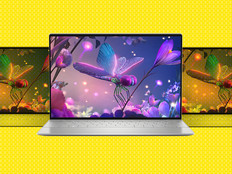UMPC Market Poised For Growth
Over the past year, the ultra-mobile PC (UMPC) market has gained momentum, steadily expanding its manufacturer and customer base. While many still consider UMPCs to be a niche product line because of the small shipment volumes, experts say this market is poised to expand fast and soon, as a result of decreasing prices and the appearance of simpler, low-cost devices. As more companies enter this field, there has been a steady improvement in the UMPC’s processing power, features and battery life. Here are some of the latest UMPC models on the market:
Gigabyte recently introduced two of its latest UMPC models: the M700 and M704. The M700, a compact device with no keyboard, weighs about 1.4 pounds. Powered by VIA’s 1.2GHz CPU, the M700 sports a 7-inch, 1024x600 touch-sensitive display and runs Vista Home Premium using 2 gigabytes of RAM. Other features include a storage capacity of 60GB, a built-in webcam, GPS and a Wi-Max-capable ExpressCard slot. The company has not yet disclosed the pricing details or release date.
For those of you who still want a keyboard on the go, Gigabyte has developed its M704 model, which has specifications similar to the M700. The M704 also has a slightly longer battery life, four hours, as opposed to the M700’s three hours. The M704 has already hit the market and can be purchased for about $1,600.
Earlier this year, Gigabyte released its own mobile Internet device, the M528. The M528 is an ultra-compact mobile PC, based on Intel’s 800MHz Menlow chip, with a 4.8-inch, 800x480 touchscreen. It runs Linux, includes a slide-out keyboard and weighs less than a pound. Other features include 512 megabytes of memory, built-in GPS and a 4GB SSD (solid-state disk). One of the two cameras integrated into this device has a 3-megapixel resolution — a first of this kind for such a device. According to Gigabyte, the M528 will be released in mid-2008 and is estimated to cost about $750. According to techie site Gearlog, the product is expected to ship in Taiwan in late July—there’s no word yet on American shipping.
This year, Asus launched its R70 UMPC, which uses a 7-inch touchscreen and is powered by Intel’s 1.6GHz CPU. This keyboard-less device, which follows up the company’s previous 5-inch R50 model, runs Windows Vista and has an integrated GPS. The R70 features a 120GB hard disk drive, a 3.5G wireless adapter, a web camera and a fingerprint scanner, which is becoming increasingly popular in many UMPCs.
The Asus Eee PC subnotebooks, released this year in a wide range of colors, received quite a bit of attention in the UMPC market. Asus’ 7-inch Eee PC (700 series) runs Linux and features 512MB of RAM, a 4G SSD hard drive, a webcam and an SD card slot.
However, shortly after showing off the 7-inch series, Asus announced it would expand the Eee PC family with an 8.9-inch model (900 series). This slightly heavier sub-notebook, capable of running Windows XP and Linux out of the box, is already available for purchase, sporting a 1024x600 display with built-in webcam, along with 1GB of RAM and 12/20GB SSD (4GB built-in plus 8/16GB flash-based). This newest addition to the Eee PC family is estimated to cost about $600 for the 12GB version.
The new Eee PC, which, like its predecessor, is powered by Intel’s 900MHz Celeron-M processor, will also feature a novel FingerGlide touchpad capable of recognizing two-finger gestures for actions such as zooming in or out and scrolling. The company also says it is developing a 10-inch model, which will have a more advanced Intel CPU (Atom). The same CPU will also find its way to another version of the 900 series, known as the Eee PC 901. The 901 will also include an integrated Bluetooth feature.
Panasonic recently unveiled a UMPC from the Toughbook series, a shock-resistant and water-resistant device that weighs slightly more than 2 pounds. This mobile PC, which is equipped with a 5.6-inch touchscreen and full keyboard, uses Intel’s new Atom CPU and runs Windows XP or Vista. Similar to other Toughbook products, this device, dubbed CF-U1, is designed for use in extreme environments. There are no major surprises in its specifications, except that the number pad is positioned in the middle of the QWERTY keyboard. The CF-U1’s release date is scheduled for fall 2008, and the company has yet to disclose pricing details.
Earlier this year, Samsung demonstrated a successor to its Q1 Ultra UMPC model, the Q1 Ultra Premium. According to the company, this premium model is three times faster than the original Q1 because of its 1.33GHz “Core Solo” CPU from Intel. The model, this year’s Innovations Honoree at the annual Consumer Electronics Show (CES), runs Windows XP and is equipped with a 6-cell battery, which allows for 7.5 hours of battery life. Q1 Premium weighs slightly less than 2 pounds, and Samsung says it was designed to provide comfortable mobility and high-performance capabilities.
“With the Q1 Ultra Premium, Samsung has leveraged Intel’s Ultra-Low Voltage Pentium CPU to deliver an even higher-performing solution for those needing to support the latest and most advanced applications,” says Bret Berg, senior product marketing manager at Samsung. The new-generation model, which bears larger and improved keycaps, also features 1GB of DDR2 RAM and maintains its original hard drive capacity of 80GB. The device is also integrated with Wi-Fi and Bluetooth connectivity and comes with a built-in fingerprint reader and two cameras — one of them a 1.3-megapixel camera.
Another notable mini-PC was developed by the tech giant LG, which recently unveiled its XNote B831 UMPC. The XNote is a slide-out device with a full QWERTY keyboard and a 1024x600 4.8-inch stylus-enabled touchscreen. This device runs on Intel’s Menlow processor and includes support for HSDPA, Bluetooth and Wi-Fi. Running Windows Vista, the computer weighs slightly more than a pound and includes a 40GB hard drive and 1GB of RAM.






